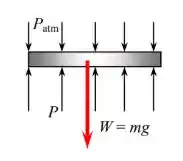Um dispositivo de cilindro e pistão sem atrito e vertical contém um gás a . A pressão atmosférica externa é de e área do pistão é de . Determine a massa do pistão.
Passo 1
Fala aí galera, bora fazer mais uma questão de MecFlu para ficar craque e mandar aquele notão na prova. Primeiramente, temos o desenho do diagrama de corpo livre do pistão:

Com isso, vamos agora equilibrar o rendimento das forças verticais a fim de encontrar a massa do pistão. Para isso, basta igualrmos o somatório das pressões no eixo vertical a zero. Fica assim: